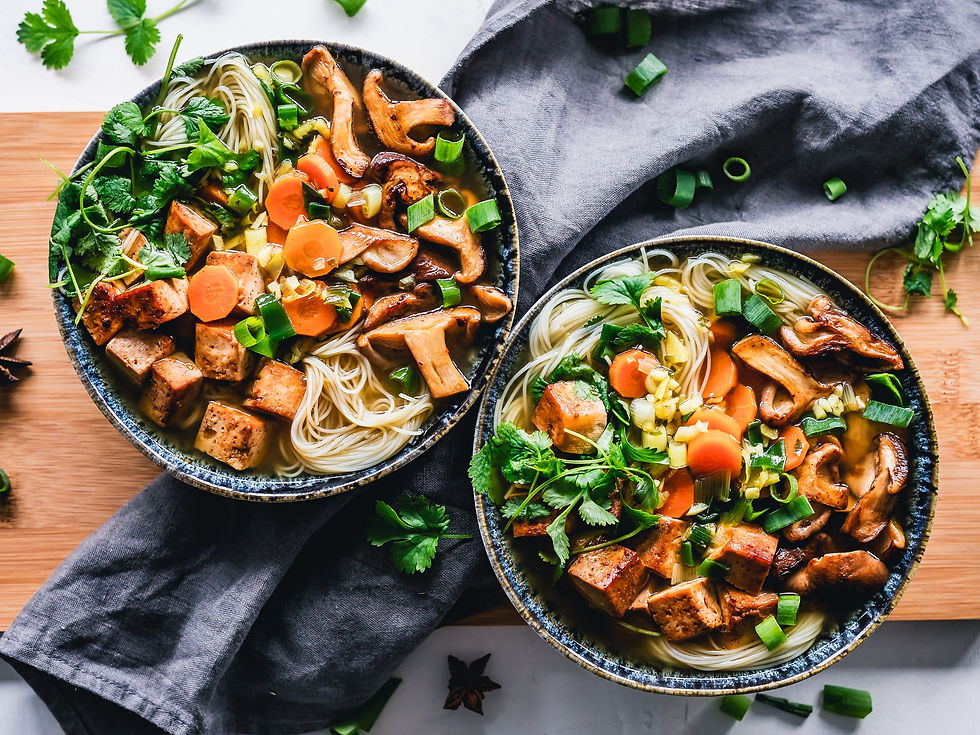How to make Sustainable Living Sustainable for YOU
- Emily Fairs
- Jul 26, 2023
- 4 min read
In a world where sustainable eating is becoming more necessary, here are some top tips for making it sustainable for yourself, including a delicious recipe at the end!

As pollution on our planet increases at an alarming rate, our anxiety increases with it; will all the wildlife die? Will we survive much longer? How can we prevent this from happening?
Every year, we produce 400 million tonnes of plastic waste - that's an astonishing amount! Although it may seem futile, our cooperation in saving the planet is crucial: every little helps!
Plastic is something that can easily be cut down in our lives, but more often than not, this comes at a hefty price. This article will provide you with some top tips and tricks for reducing plastic waste, and allowing for a more sustainable lifestyle around food, and will provide a simple, versatile recipe at the end.
The Easiest, Cheapest Ways to Eat Sustainably
The easiest way to cut single-use plastic out of your weekly food shop is to buy loose fruits and vegetables in the supermarket, instead of pre-packed bags. Not only does this cut out plastic, it also ensures that you don't waste a lot of unused produce that has gone mouldy before you get a chance to use it. Think about how many people your meals have to feed; if it's just yourself, do you really need a pack of 15 carrots for the week?
Meal Plan. It may sound like a hassle, but planning your main meals for the week can save you incredible amounts of waste and money! Some people like to buy whiteboards and display their weekly menu, but you can easily write down a meal plan for the week on your phone. This also helps you create a useful shopping list, and instead of just buying random ingredients, you are buying the necessary ingredients for each recipe. This also helps to plan out meals where ingredients can be used for more than one meal per week. For example, you could make stuffed peppers one day then use the remaining pepper in a salad or a wrap another day.
Try going vegetarian or vegan! I'm not saying you need to completely change your lifestyle forever, but trying to eat a meat-free meal just one or two days a week can save the planet huge amounts. Although meat-free alternatives can often be quite pricey, supermarkets always have certain products on offer - or if not head to the freezer section! The products in there are always brilliant value for money and are just as delicious!
Buy local greens! More often than not, local produce is both cheaper and fresher. Most cities have at least one greengrocer, sometimes on a market, and some smaller towns even have places you can buy fresh fruit and veg!
Recycle, recycle, recycle! Sometimes buying food in single-use plastic is unavoidable - and that's okay! If you are eating something that only comes in plastic packaging, read the side to see if you can recycle it. Some materials look and feel like plastic but they are actually recyclable materials, and some packaging can be taken to supermarkets to be recycled. Even recycling a couple of pieces a day can help slow down climate change and protect the planet from pollution.
Try This Delicious, Affordable, and Sustainable Recipe!

Ingredients
One cauliflower
2 tablespoons vegetable oil
1/2 tablespoon cumin
1 tablespoon garlic
1 tablespoon ginger
1/2 tablespoon paprika
1/2 teaspoon salt
1/2 teaspoon ground pepper
Although this looks like a lot of ingredients, most of them are spices. Spices are brilliant; you typically use very small quantities when cooking and they don't go out of date for months! They also come in glass jars, so no plastic, and are often found in zero-waste shops. This means you can continue to use the same container without causing unnecessary waste!
Method
Preheat the oven to 200° (an air fryer can also be used if you have one!).
Wash and chop up your cauliflower into florets. These can be any size you like, but try to keep all the pieces a similar size to ensure they all cook the same!
Place the florets in a large bowl. You will be tossing your ingredients so make sure your bowl is big enough for this.
Add the oil and all the spices.
Toss them all together until all the cauliflower is coated - try to leave as few white gaps as possible.
Place all the florets onto a baking tray and evenly spread them out.
Place on the middle shelf of the oven for 15-20 minutes, regularly checking on the cauliflower. You might want to shake them or toss them over halfway through.
Serve with your favourite dip or use as a side dish for your favourite meals!
And that's it! Easy peasy! Eating sustainably doesn't have to cost you hundreds of pounds a week, and it also doesn't have to be a lot of hassle. By following all the above steps, you will become more eco-aware, and eventually, you won't even have to think about things like recycling and smart shopping - it will just come naturally!
For more easy, sustainable recipes, you can click here.
Comments